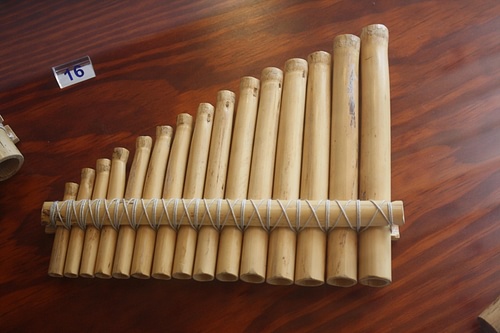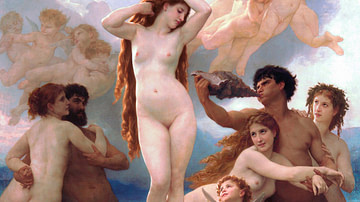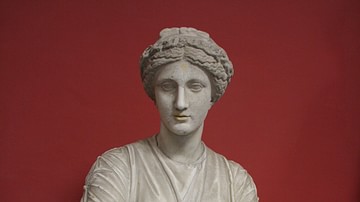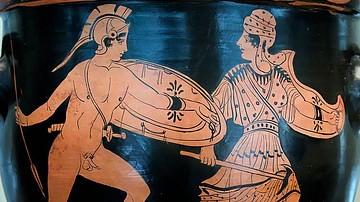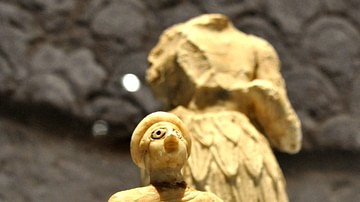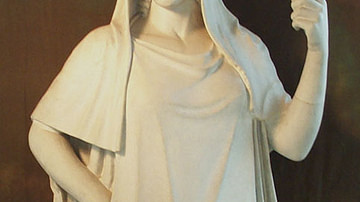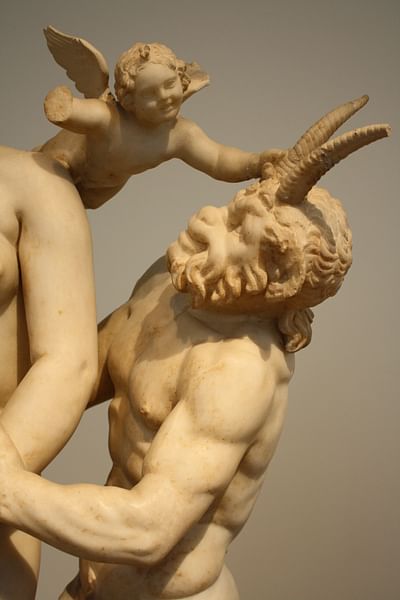
Pan is a figure from Greek mythology who was originally a pastoral god from Arcadia. It was believed Pan dwelt in the mountains and forests of Greece. He was the patron of shepherds, hence one of his attributes is the lagobolon - a hare trap. Not fully human in form, Pan's legs are that of a goat and he has horns sprouting from his head. Pan was strongly associated with music and its magical powers; he is credited with inventing the syrinx musical instrument, better known as the panpipes.
Pan Invents the Panpipes
A wide assortment of myths surround Pan's parentage but Hermes is most often named as his father and a Nymph as his mother. In Greek mythology, Pan fell in love with the beautiful nymph Syrinx, daughter of Ladon the river-god. Fleeing his attentions, Syrinx pleaded with Zeus to save her and just when Pan captured the wood nymph, Zeus turned her into reeds. Enraged, Pan smashed the reeds into pieces but on reflection he was struck with remorse and wept and kissed the broken reeds, all that remained of his beloved. As he kissed the reeds he discovered that his breath could create sounds from them and so he made the musical instrument that would carry the lost nymph's name.
Other female figures who aroused the affections of Pan were the nymphs Echo and Pitys and also Selene, the personification of the moon. Finally, in some myths, Pan also had amorous intentions towards the goddess Aphrodite.
How Was Pan Worshipped?
Caves were often associated with worship of the god, notably, the Korkykeion cave on the slopes of Mt. Parnassos which was dedicated to the worship of both Pan and the Nymphs. Another cave used as a point of worship was the Vari cave in Attica. Shepherds, in particular, sacrificed to the god, usually kids, goats or sheep or offered small herdsmen statues made of clay as votive offerings. Other typical offerings to Pan included vases, lamps and grasshoppers made of gold. Along with Artemis, he was also held in high esteem by hunters and his realm was seen as that of small game such as wild birds. Pan was particularly associated with Delphi and Athens, where a cult to the god was established which included castrated goat sacrifices and torch races. According to myth (told by the Greek historian Herodotus) this cult was established in return for Pan's assistance to the Athenians at the battle of Marathon.
How Was Pan Represented in Art?
Pan appears in Greek art from around 500 BCE and in his early representations on Greek pottery he is all-goat, standing upright on his hind goat legs. In later red-figure pottery he acquires a human upper body and head but with goat horns and is often in the company of Maenads and Satyrs. The god also became associated with the rituals and festivities associated with Dionysos. In the 4th century BCE Pan appeared on the reverse side of coins minted for the Arcadian League.
In the Hellenistic period, the popularity of the god increased and he became associated with the panic which could spread amongst soldiers in the heat of battle. A similar excess of violent emotion (panolepsia) could also overcome an individual. In Roman times the god became known as the All, a sort of universal god, which was a play on the other meaning of the word pan.
